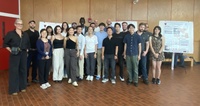Citation:
145 -, Ziad AT, Zimmerman JF, Rao J, Sieiro D, McNamara HM, Cherrier T, Rodriguez-delaRosa A, Hick-Colin A, Bousson F, Fugier-Schmucker C, Marchianoi F, Habermanni B, Chala J, Nesmith AP, Gapon, Svetlana, Wagner E, Gupta VA, Bassel-Dubyk R, Olsonk EN, Cohen AE, and Parker KK. 7/2021. “
Prednisolone Rescues Duchenne Muscular Dystrophy Phenotypes in Human Pluripotent Stem Cell–Derived Skeletal Muscle in Vitro.” Proceedings of the National Academy of Sciences of the United States of America, 118, 28, Pp. 1-12.
Publisher's VersionAbstract:
Duchenne muscular dystrophy (DMD) is a devastating genetic disease leading to degeneration of skeletal muscles and premature death. How dystrophin absence leads to muscle wasting remains unclear. Here, we describe an optimized protocol to differentiate human induced pluripotent stem cells (iPSC) to a late myogenic stage. This allows us to recapitulate classical DMD phenotypes (mislocalization of proteins of the dystrophin-associated glycoprotein complex, increased fusion, myofiber branching, force contraction defects, and calcium hyperactivation) in isogenic DMD-mutant iPSC lines in vitro. Treatment of the myogenic cultures with prednisolone (the standard of care for DMD) can dramatically rescue force contraction, fusion, and branching defects in DMD iPSC lines. This argues that prednisolone acts directly on myofibers, challenging the largely prevalent view that its beneficial effects are caused by antiinflammatory properties. Our work introduces a human in vitro model to study the onset of DMD pathology and test novel therapeutic approaches.
